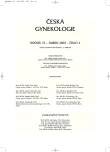Contribution of Neoadjuvant Chemotherapy for Operability of Cancers of the Uterine Cervix
Přínos neoadjuvantní chemoterapie pro operabilitu zhoubných nádorů děložního hrdla
Cíl studie:
Srovnání peroperační a pooperační morbidity u pacientek radikálně operovaných pro karcinom děložního hrdla po podání neoadjuvantní chemoterapie a pro primárně malý nádor děložního hrdla.
Typ studie:
Retrospektivní case-control studie.
Název a sídlo pracoviště:
Gynekologicko-porodnická klinika 1. LF UK a VFN, Praha.
Metodika:
Do studie bylo zařazeno 24 pacientek s dlaždicobuněčným karcinomem děložního hrdla, u nichž byla od 1/2004 do 6/2006 provedena radikální hysterektomie se systematickou pánevní lymfadenektomií po předchozím podání neoadjuvantní chemoterapie (NACT). Kontrolní skupina 24 pacientek byla vybrána retrospektivně ze souboru radikálně operovaných žen ve stejném období, avšak pro primárně malý nádor děložního hrdla stadia IA2 či IB1. Kritériem pro výběr kontrolní skupiny byla velikost nádoru odpovídající zmenšenému nádoru po aplikaci NACT. V obou souborech byly sledovány následující parametry – operační čas, krevní ztráta objektivizovaná rozdílem hodnot předoperačního a pooperačního hemoglobinu a hematokritu, nutnost podání krevní transfuze, peroperační komplikace, časné pooperační komplikace (do 6 týdnů po operaci), doba hospitalizace a ponechání zavedené epicystostomie pro hypotonický močový měchýř do domácí péče.
Výsledky:
U 92 % pacientek bylo po NACT dosaženo klinické odpovědi, která umožnila provedení radikální operace. Po NACT byl objem původního nádoru zmenšen průměrně o 70 % (58–100 %). Mezi skupinou pacientek léčených NACT s následnou radikální hysterektomií a kontrolní skupinou radikálně operovaných pro primárně malý nádor děložního hrdla nebyl významný rozdíl v operačním čase (165 min. vs. 160 min.), krevní ztrátě (rozdíl předoperačních a pooperačních hodnot hemoglobinu 18 g/l vs. 19 g/l, rozdíl předoperačních a pooperačních hodnot hematokritu 0,056 vs. 0,064), podání krevní transfuze (25 % vs. 21 %) a délce hospitalizace (9,5 dne vs. 9,6 dne). Významný rozdíl byl pouze v potřebě ponechání zavedené punkční epicystostomie do domácí péče (67 % vs. 47 %).
Závěr:
V hodnocených parametrech peroperační a pooperační morbidity u pacientek po NACT a u pacientek v kontrolním souboru nebyly významné rozdíly. Výjimkou je pouze potřeba delšího ponechání umělé derivace moči u pacientek po NACT podmíněná větší radikalitou výkonu na parametriích. Podání NACT v režimu ifosfamid / cisplatina (IP) zlepšilo operační podmínky u bulky dlaždicobuněčných karcinomů děložního hrdla.
Klíčová slova:
karcinom děložního hrdla, neoadjuvantní chemoterapie, radikální hysterektomie
Authors:
J. Sláma; D. Cibula; P. Freitag; D. Fischerová; M. Janoušek; D. Pavlišta
; M. Strunová; Michal Zikán
; N. Jančárková
Authors‘ workplace:
Gynekologicko-porodnická klinika VFN a 1. LF UK, Praha, přednosta prof. MUDr. A. Martan, DrSc.
Published in:
Ceska Gynekol 2007; 72(2): 116-119
Category:
Original Article
Overview
Objective:
To compare per-operative and post-operative morbidity in patients undergoing radical surgery for carcinoma of the uterine cervix after administration of a neoadjuvant chemotherapy, and for primarily small cervical tumour.
Type of the study:
A retrospective case-control study.
Setting:
Department of Obstetrics and Gyneacology, 1st Faculty of Medicine, Charles University and General Teaching Hospital, Prague.
Methods:
The study included 24 patients with squamous cell carcinoma of the uterine cervix who underwent radical hysterectomy including systematic pelvic lymphadenectomy after previous administration of neoadjuvant chemotherapy (NACT) during the period between 1/2004 and 6/2006. The control group of 24 patients was selected retrospectively from the population of women after radical surgery carried out in the same period, nevertheless, the controls underwent the surgery for primarily small carcinoma of the uterine cervix, stages IA2 or IB1. The tumour size consistent with the reduced tumour after NACT administration was the criterion for selection of the control group. The following parameters were monitored in both groups – duration of the surgery, blood loss objectivised by a difference in pre-operative and post-operative haemoglobin and haematocrit values, the need of blood transfusion, per-operative complications, early post-operative complications (up to 6 weeks after the surgery), duration of hospitalization and retaining the inserted epicystotostomy due to hypotonic bladder after discharge.
Results:
A therapeutic response allowing the radical surgery was achieved in 92% patients after NACT. After NACT the original tumour volume was reduced by 70% on the average (58% – 100%). No significant differences between the group of patients treated with NACT and undergoing subsequent radical hysterectomy and the control group were reported in terms of duration of the surgery (165 min. vs. 160 min.), blood loss (the difference in pre-operative and post-operative haemoglobin values 18 g/l vs. 19 g/l, the difference in pre-operative and post-operative haematocrit values 0.056 vs. 0.064), administration of blood transfusion (25% vs. 21%) and duration of hospitalization (9.5 days vs. 9.6 days). A significant difference was reported only in the need to retain the inserted epi-cystostomy after discharge (67% vs. 47%).
Conclusion:
There were no significant differences in the evaluated parameters of per-operative and postoperative morbidity in patients after NACT and in control patients, except for the necessary duration of artificial urine derivation in patients after NACT due to the fact that their surgery was more radical in the parametria. Administration of NACT regimen involving ifosfamide / cisplatin (IP) improved surgical conditions in the bulky squamous cell carcinoma of the uterine cervix.
Key words:
cervical carcinoma, neoadjuvant chemotherapy, radical hysterectomy
Labels
Paediatric gynaecology Gynaecology and obstetrics Reproduction medicineArticle was published in
Czech Gynaecology

2007 Issue 2
Most read in this issue
- Acute Fatty Liver of Pregnancy (AFLP) – Case Report
- Late (Non-classic) Adrenal Hyperplasia
- Biochemical Parameters of the Intrahepatic Cholestasis of Pregnancy
- Intrahepatic Cholestasis in Pregnancy – Guidelines of Treatment
